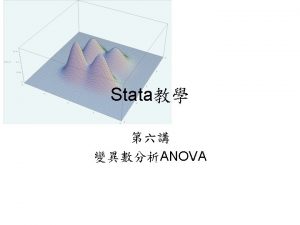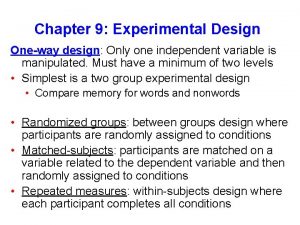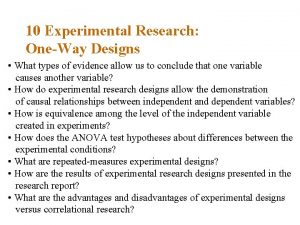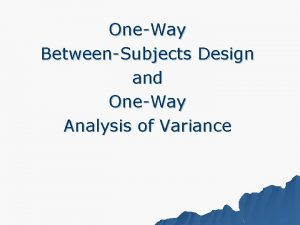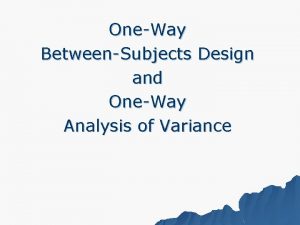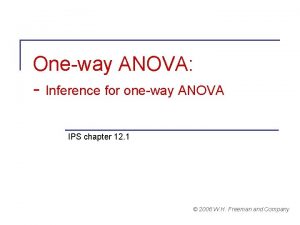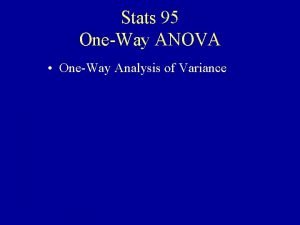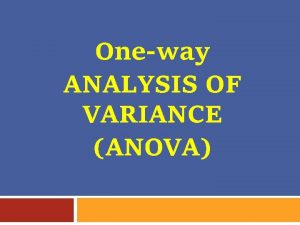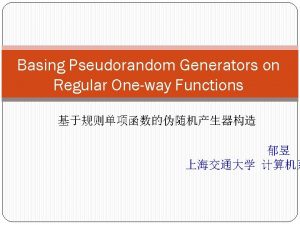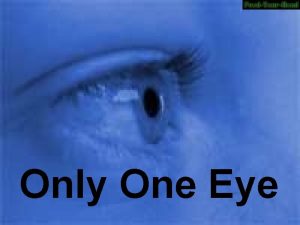Chapter 9 Experimental Design Oneway design Only one



















- Slides: 19

Chapter 9: Experimental Design One-way design: Only one independent variable is manipulated. Must have a minimum of two levels • Simplest is a two group experimental design • Compare memory for words and nonwords • Randomized groups: between groups design where participants are randomly assigned to conditions • Matched-subjects: participants are matched on a variable related to the dependent variable and then randomly assigned to conditions • Repeated measures: within-subjects design where each participant completes all conditions

• Posttest design: measure participants on the dependent variable only after the independent variable is manipulated. • Pretest-Posttest design : Participants are first tested on the dependent variable, then the independent variable is manipulated, and then they are again tested in the dependent variable. • Ensures participants in each condition were initially equivalent in the dependent variable. • If there is a pretest score, researchers can see how much the dependent variable changed. • More powerful design, making it easier to detect effects of the independent variable.

• Pretest sensitization: pretest may sensitize participants to respond to the independent variable differently than they would if they did not have the pretest. • Examining effect of caffeine on memory. First pretest all participants on the memory test, then give one group caffeine and the other group a placebo, and then test their memory again. • The memory pretest may affect their later performance on the memory test (may have practiced, are more familiar with the test).

Factorial Design • One-way design: test one independent variable • Factorial design: manipulate two or more independent variables. • Factor: refers to each independent variable • Two-way design: two independent variables • Three-way design: three independent variables: 2 x 2 design (two way) with 2 levels of each independent variable Words Short Long Nonwords

3 x 3 design is a two way design with three levels of each independent variable 100 0 5 10 200 300

2 x 3 is a three way design (three independent variables) with two and three levels each A 1: Words B 1 B 2 A 2: Nonwords B 1 B 2 C 1 C 2 C 3

2 x 3 is a two way design (two independent variables) but one variable has two levels and one variable has three levels

Assignment of participants to conditions: • Randomized groups factorial design: participants are randomly assigned to one of the combinations of the independent variables • Matched factorial design: match participants based on their score on a measure related to the dependent variable. • If there are 6 cells then choose six highest scores and randomly assign each to a cell. • Repeated measure factorial design: all participants complete all conditions (cells) • So in a 2 x 2 (4 cells) each participant completes 4 conditions, in a 3 x 2 (18 cells) each participant completes all 18 conditions

• Mixed factorial design: has at least one between and one within subjects variable. • 2 x 2, one independent variable between subjects (caffeine no caffeine) and other independent variable is within subjects (visual memory test, verbal memory test) • Randomly assign participants to the between subjects condition and all participants complete the within subjects condition.

Main Effect: when there is an effect (or difference) for one independent variable, collapsing across the other independent variable. • 2 (caffeine, no caffeine) x 3 design (short, medium, long words). • It is a two way design, so there will be two main effects (one for caffeine and one for word length) • If there is a main effect of caffeine, that means that memory is better in individuals who have caffeine regardless of the length of words (average across words). • If there is a main effect of word length it may be that memory is better for shorter than longer words, collapsing across caffeine intake.


Interaction: Occurs when the influence of one independent variable is different at different levels of another independent variable. • 2 (caffeine, no caffeine) x 2 design (short, long words) • The effect of caffeine on memory may be different for short words than for long words. • Caffeine may only have a positive effect on memory for short words, but there may be no difference between caffeine and no caffeine groups for long words. • Caffeine interacted with word length

Memory for Words as Function of Word Length and Caffeine Intake

No interaction, the lines are parallel. The effect of therapy is the same for the drug and no drug group.

A strong interaction, the effect at one level of the independent variable is opposite of the other level.

Higher-Order designs: • Three-way designs: 2 x 3 • There will be three main effects (A, B, C) • There will be three two-way interactions: A by B (ignoring C), A by C (ignoring B), and B by C (ignoring A). • There will be one three-way interaction (A by B by C).

Subject Variable: based on individual personal characteristics that you can not manipulate but you can measure (age, IQ, gender). Expericorr (mixed) design: has at least one independent variable manipulated by the researcher and at least one subject variable (gender) measured but not manipulated. • Allows researchers to examine effects of a subject variable • Help to understand how personal characteristics relate to behavior (age, gender) • Dividing participants into groups based on a subject variable makes the participants in each group more homogeneous

Classifying participants into groups: • Median-split procedure: divide participants into two groups based on the median score (half of the participants above and half below this score). • Extreme groups procedure: divide participants into two groups based on very high and low scores on a variable of interest. • These procedures can throw away valuable information. • With median split the participants may not truly be high or low, they may just be high or low in the sample but not in the population.

Cautions with mixed designs: • The subject variable it not manipulated so this simply provide correlational findings, but not causality.
 Stata oneway
Stata oneway Jeff boote
Jeff boote Oneway hash
Oneway hash Experimental vs non experimental
Experimental vs non experimental Experimental vs non experimental
Experimental vs non experimental Solomon four group design
Solomon four group design Experimental vs non experimental research
Experimental vs non experimental research Nonexperimental study
Nonexperimental study One way experimental design
One way experimental design What is a one way design
What is a one way design Take only photographs leave only footprints
Take only photographs leave only footprints One god one empire one emperor
One god one empire one emperor One one little dog run
One one little dog run One king one law one faith
One king one law one faith One empire one god one emperor
One empire one god one emperor One team one plan one goal
One team one plan one goal See one do one teach one
See one do one teach one One price policy
One price policy Willow cabin speech
Willow cabin speech See one do one teach one
See one do one teach one
